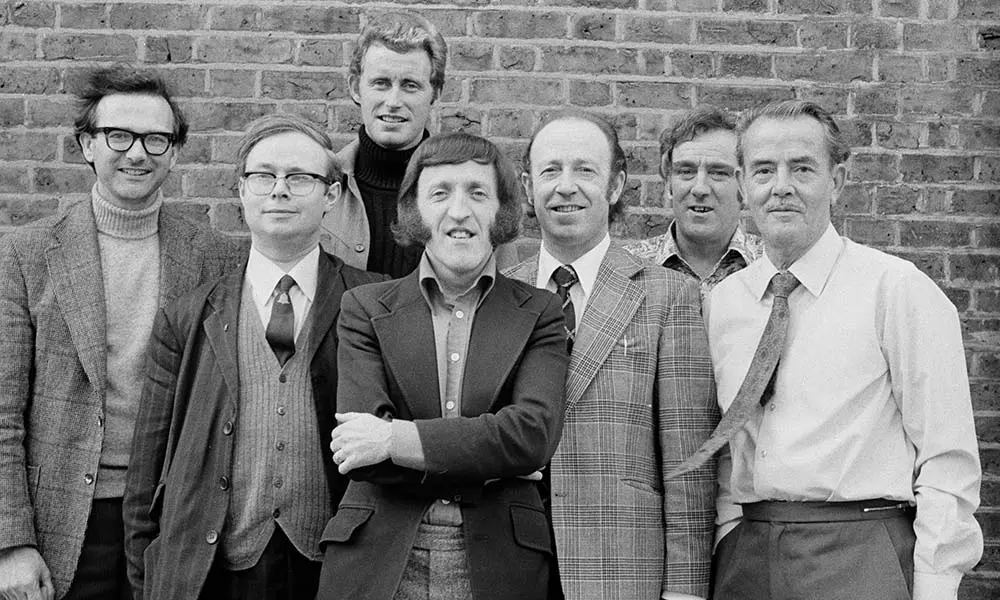Best Chieftains Songs: 20 Essential Traditional Irish Tunes
The Chieftains are the world’s principal ambassadors of traditional Irish music, and their best songs prove why they are so beloved.

Quite simply, The Chieftains are the world’s principal ambassadors of Irish music. The band, formed in 1962 by Paddy Moloney to play traditional Irish tunes that celebrated his homeland’s folk culture, have released more than 40 albums, won six Grammy awards, and played private shows at the White House and the Vatican City. The Rolling Stones singer Mick Jagger hailed their “mind-boggling” contribution to the history of popular music. President Joe Biden has described them as his favorite band.
The Chieftains have worked with rock and pop stars, opera singers, and classical and folk musicians from around the world. They also have a distinguished legacy of soundtrack work, including the songs they contributed to the Oscar-winning soundtrack of Stanley Kubrick’s 1975 movie Barry Lyndon. “You could call the music we play the classical music of Ireland,” said Dubliner Moloney, who passed away in October 2021 at the age of 83. Below we offer a selection – and it can only be that, given the depth of their incredible body of work – of the best tracks by The Chieftains.
Listen to Chronicles: 60 years of The Chieftains here.
Titans of traditional music
It is no exaggeration to say The Chieftains reinvented traditional Irish music on an international scale, fulfilling Moloney’s vision of popularizing the jigs, reels, polkas, and gorgeous slow melodic airs he grew up enjoying as a youngster. Moloney, who started out playing with a band called Ceoltóirí Chualann, was 24 when he gathered a group of players together in Dublin in 1962, semi-professional musicians who would later evolve into The Chieftains. The band’s name was inspired by his friend, Irish poet John Montague, and his 1964 short story collection Death of a Chieftain.
That was the year The Chieftains released their first album on Garech Browne’s Claddagh Records. They would go on to record dozens of records for the label, and some of the band’s best instrumental tracks were recorded there, including the rollicking reel “Boil The Breakfast Early,” from the 1979 album The Chieftains 9: Boil The Breakfast Early, the first of their albums to feature the flute playing of Matt Molloy.
The lovely jig “If I Had Maggie in the Wood” (from Chieftains 8), the romantic air “Tabhair dom do Lamh” (from Chieftains 5), and the polka “Sweeney’s Polka” (from Chieftains 2) are good examples of their imaginative, innovative interpretations of traditional songs. One of the best examples of this approach is the instrumental “Mná na hÉireann” (which translates as “women of Ireland”), which appeared on the 1973 album The Chieftains 4, the first of their records to feature Derek Bell on harp. It was this song that brought them to the attention of acclaimed director Stanley Kubrick.
Ireland’s virtuoso musicians
Although Bell once quipped that The Chieftains “have the look about us of a group of retired bankers,” their unshowy image has always belied a collection of supremely talented musicians. Bell, who was given the nickname “Ding Dong” by the band, was a wizard on a wide range of instruments, including the Celtic harp, oboe, piano, electric keyboard, English horn, and hammered dulcimer. Like Bell, fiddler and founding member Martin Fay was classically trained. Seán Keane, who joined the band in 1968, was an all-Ireland fiddle champion. Michael Tubridy excelled on the concertina, tin whistle, and flute.
Moloney was not only a brilliant artist on the bellows-blown instrument known as the uilleann pipes, but he also played other Gaelic instruments including the bodhrán, the tin whistle, and button accordion. In 1969, his band took “The Foxhunt,” which had previously been known as a piper’s tune, and created the definitive full-band version. The tune, arranged by Moloney, was an important milestone. By the time of 1973’s The Chieftains 4, Moloney was creating ambitious compositions such as “The Battle of Aughrim.” As he was writing the song, Moloney visited the site of the 17th-century battle in Galway, where nearly 7,000 people were killed. “The whole picture of the battle started to evolve in my mind like a vision… I could see the bloody battlefields and all the great patriots lying dead and then it all started coming together for me,” Moloney recalled in The Chieftains: The Authorised Biography.
The Chieftains have always been consummate live performers and some of their concert albums, including 1976’s Chieftains Live album, recorded at the Symphony Hall in Boston and the Massey Hall in Toronto, gives a taste of the energy and skill they brought to their shows. That album included a particularly moving instrumental version of “Carrickfergus.” That tour sealed their reputation in America and news of their talent continued to spread. “These guys are the real deal,” said New Orleans pianist Dr. John in 1995.
The Chieftains’ sense of adventure
The Chieftains have excelled at breaking down musical barriers throughout their career, taking Irish music to the farthest parts of the world. They were the first Western musicians to perform on the Great Wall of China; they were part of Roger Waters’ historic The Wall performance in Berlin in 1990; they were the first ensemble to perform a concert in the Capitol Building in Washington D.C. In 2010, Molloy’s prized E-flat flute was played in space by NASA astronaut Cady Coleman.
During that 1983 tour of China, The Chieftains included a 20-minute jam session with native musicians at every concert. Their infectious appreciation of Chinese music is shown in the track “Full of Joy,” on which bodhrán player Kevin Conneff played the Chinese gong. On The Chieftains 5, Bell introduced the medieval tiompán to The Chieftains sound for the first time, on Moloney’s composition “Tiompán Reel.” That album, which was released in America by Island Records, also featured Breton music for the first time, with the haunting “Ceol Bhriotánach.”
Another example of their unique ability to play and arrange tunes that bring out the best of Irish and overseas music was Moloney’s stirring 11-minute tune “Galacian Overture.” The track was the highlight of Santiago, a Grammy-winning album that is dedicated to the traditional music of Spain’s Galicia region. Ry Cooder, who guested on the album, once joked, “I swear Paddy thinks all the music in the world originally came from Ireland.”
The Chieftains’ collaborations
Paul McCartney, Elvis Costello, Willie Nelson, Emmylou Harris, Joni Mitchell, Nanci Griffith, Jackson Browne, Art Garfunkel, Béla Fleck, Bonnie Raitt, Madonna, Diana Krall, Marianne Faithfull, Tom Jones, Alison Krauss, Sinéad O’Connor, John Williams, James Galway, and Luciano Pavarotti have one thing in common: they all jumped at the chance to record with The Chieftains.
One of The Chieftains finest instrumental unions was with Ry Cooder, on a majestic version of “Dunmore Lassies,” a track from their hit album The Long Black Veil. The band were entirely instrumental until 1976’s The Chieftains 6: Bonaparte’s Retreat, when the gorgeous title track “Bonaparte’s Retreat” featured 17-year-old singer Dolores Keane, from the band De Dannan. Their ability to provide accompaniment for vocalists has since become a feature of some of their best work, including the 1988 album Irish Heartbeat, featuring 10 songs with Van Morrison. The whole album, which includes a rousing version of “I’ll Tell Me Ma,” is a triumph.
The Chieftains have also excelled at working with country and western musicians, including Patty Griffin, Lyle Lovett, John Prine, Chet Atkins, and Rosanne Cash. One of their best Nashville collaborations was with Ricky Skaggs on a zestful version of “Wabash Cannonball.” The opening of that song was adapted from their song “Morning Dew,” which came on Chieftains 4, sleeve notes for which were penned by Peter Sellers, the celebrated comedian and movie star.
Stars of the big screen
Whether it’s dance tunes to lift your spirits, or songs to tug at your heartstrings, The Chieftains have excelled at creating atmospheric music. It is no surprise that these Irish folk musicians have been in huge demand for Hollywood soundtracks and television programs. As well as their work for Kubrick, they wrote and performed music for the 1979 movie Tristan and Isolde, starring Richard Burton. The lovely theme tune “Tristan and Isolde,” on which Moloney blended the uilleann pipes with a symphony orchestra, is a stunning piece of music. Another film highlight is their version of “O’Sullivan’s March,” which originally appeared on 1977’s The Chieftains 7, and which they recorded anew for 1995’s Rob Roy, starring Liam Neeson.
In 1982, Moloney was commissioned to compose the score for the Canadian western movie The Grey Fox, about a famous stagecoach robber. Moloney’s sumptuous melodies worked brilliantly with the shots of old trains moving through the mountains. The score, which included “The Main Theme from The Grey Fox,” a tune Moloney adapted from his composition “Sea Image,” won a Genie Award, the Canadian equivalent of an Academy Award.
Music from The Chieftains has also appeared on hit films such as The Gangs of New York, Circle of Friends, Far and Away, and 1990’s Treasure Island, which included the spirited “Treasure Cave,” a song that is often performed live. They even made a foray into the world of cartoons, with tunes for The Tailor of Gloucester, a classic English children’s story, narrated by Meryl Streep.
Whatever the setting, whatever the style of music, The Chieftains are simply peerless. They will forever be the world’s best-loved Irish folk band.
Think we missed one of the best Chieftains songs? Let us know in the comments below. Listen to Chronicles: 60 years of The Chieftains here.












